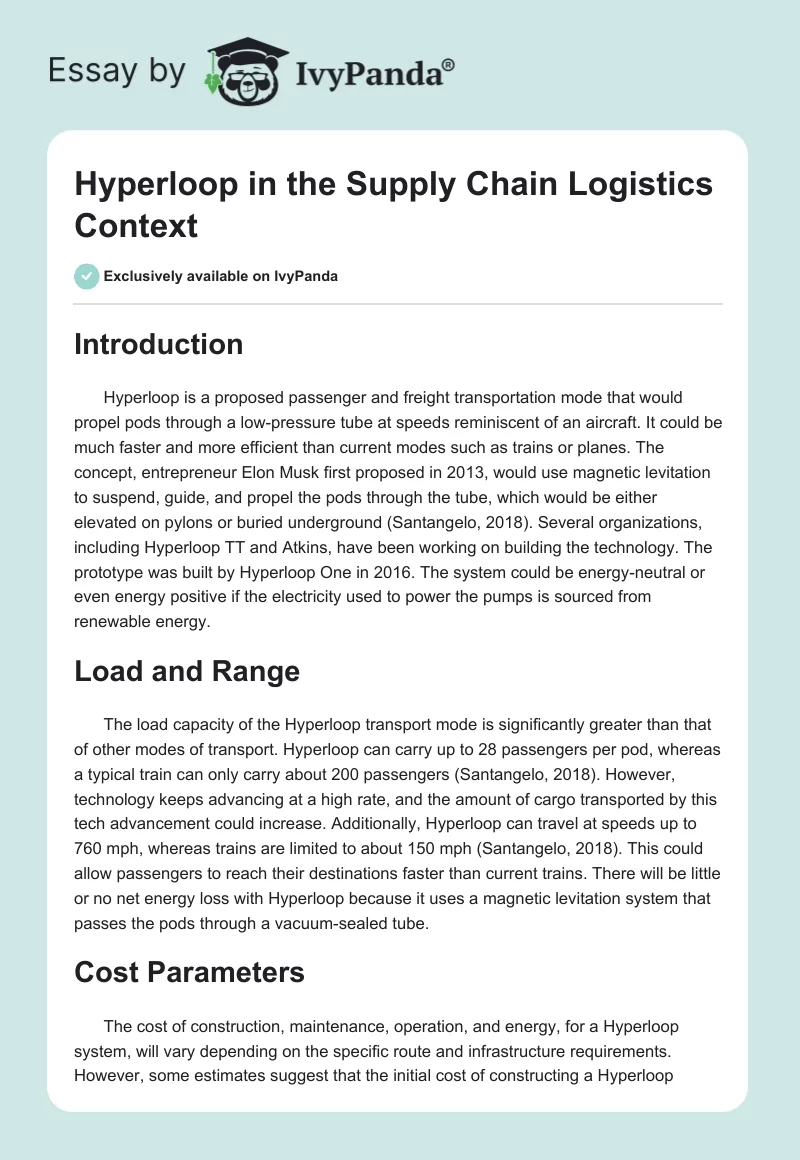Introduction
Hyperloop is a proposed passenger and freight transportation mode that would propel pods through a low-pressure tube at speeds reminiscent of an aircraft. It could be much faster and more efficient than current modes such as trains or planes. The concept, entrepreneur Elon Musk first proposed in 2013, would use magnetic levitation to suspend, guide, and propel the pods through the tube, which would be either elevated on pylons or buried underground (Santangelo, 2018). Several organizations, including Hyperloop TT and Atkins, have been working on building the technology. The prototype was built by Hyperloop One in 2016. The system could be energy-neutral or even energy positive if the electricity used to power the pumps is sourced from renewable energy.
Load and Range
The load capacity of the Hyperloop transport mode is significantly greater than that of other modes of transport. Hyperloop can carry up to 28 passengers per pod, whereas a typical train can only carry about 200 passengers (Santangelo, 2018). However, technology keeps advancing at a high rate, and the amount of cargo transported by this tech advancement could increase. Additionally, Hyperloop can travel at speeds up to 760 mph, whereas trains are limited to about 150 mph (Santangelo, 2018). This could allow passengers to reach their destinations faster than current trains. There will be little or no net energy loss with Hyperloop because it uses a magnetic levitation system that passes the pods through a vacuum-sealed tube.
Cost Parameters
The cost of construction, maintenance, operation, and energy, for a Hyperloop system, will vary depending on the specific route and infrastructure requirements. However, some estimates suggest that the initial cost of constructing a Hyperloop system could be high, although the following maintenance and operation costs could be lower compared to existing train systems (Hansen, 2020). The lower the costs, the smaller the burden on passengers and cargo transportation. Hence, Hyperloop will be more efficient for all needs of transport. The Hyperloop technology would require heavy land investment to place its highly modernized and specialized infrastructure. It would also require uniquely trained personnel to build, operate and maintain the system. Elon Musk suggested it could take around $6 billion to acquire all necessary infrastructure to make a working Hyperloop system. However, it is presumed that the cost could go way past that because of unforeseen expenses (Hansen, 2020). Once it kicks off, Hyperloop could be more cost-effective than road, train, or air transport.
Advantages of Hyperloop
Hyperloop transport is much more energy-efficient than other modes of transportation, making it more environmentally friendly This is because Hyperloop systems are powered by electricity, which is a much cleaner and more efficient energy source than fossil fuels. As a result, Hyperloop transport produces far less pollution and emissions than other modes of transportation. Besides, there is the assurance of more comfort to passengers with Hyperloop than the road, air, or train transport. This is because the Hyperloop capsules travel through a low-pressure environment, eliminating the feeling of turbulence and making for a smoother ride (Santangelo, 2018). Additionally, the pods are designed to minimize noise, meaning that passengers can enjoy a more peaceful journey.
Moreover, compared to road or air transport, Hyperloop transport will be much more reliable than other modes of transportation, meaning that delays and disruptions are less common. The system is completely automated, removing the need for human operators to be susceptible to error. Additionally, the Hyperloop technology is designed to be fail-safe so that the rest of the system can continue to operate safely if one component fails. Furthermore, Hyperloop transport is much more scalable than other modes of transport as it can easily be expanded to meet future demand. This is because the infrastructure required for Hyperloop transport is much simpler and less expensive than other modes, such as railways (US Department of Energy, 2021). Additionally, Hyperloop transport can be easily adapted to different terrain and climates, making it suitable for use in many locations.
However, some identified challenges must be met by technology, research, and government departments if Hyperloop will be more efficient than all the current five modes of transport. For example, the tubes need to be maintained at a very high vacuum, which can be difficult and expensive to achieve (Hansen, 2020). Additionally, the high speeds involved mean that any problems with the system can lead to severe accidents. Thus, engineering and tech levels applied need to have high levels of accuracy to prevent accidents (Hansen, 2020). Additionally, the technology is still relatively new and untested on a large scale. Thus, there are a lot of unknowns when it comes to potential safety issues and feasibility.
Conclusion
While the technology is still in development, and it remains to be seen if it will be a viable transportation mode in the future, the concept of Hyperloop transport has been met with considerable interest and excitement. With more research and testing, Hyperloop could be the technology that marks the sixth mode of transport. If successful, Hyperloop could provide a fast, efficient and sustainable way of transport to revolutionize travel.
References
US Department of Energy. (2021). Effect of hyperloop technologies on the electric grid and Transportation Energy. 1–52.
Hansen, I. A. (2020). Hyperloop transport technology assessment and system analysis. Transportation Planning and Technology, 43(8), 803–820.
Santangelo, A. (2018). Hyperloop as an evolution of maglev. Transportation Systems and Technology, 4(4), 44–63.


